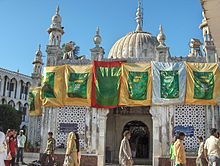- Dargah
-
A Dargah (Persian: درگاه or درگه) is a Sufi shrine built over the grave of a revered religious figure, often a Sufi saint. Local Muslims visit the shrine known as (ziyarat). Dargahs are often associated with Sufi meeting rooms and hostels, known as khanqah. They often include a mosque, meeting rooms, schools (Madrassas), residences for a teacher or caretaker, hospitals, and other buildings for community purposes.
The term is derived from a Persian word which can mean, among other uses, "portal" or "threshold". Many Muslims believe that dargahs are portals by which they can invoke the deceased saint's intercession and blessing (see Tawassul).
Over time, musical offerings of dervishes (mendicants) in the presence to the devout at these shrines, usually impromptu or on the occasion of Urs, gave rise to music genres like, Qawwali and Kafi, where Sufi poetry is put to music and sang as an offering to the murshid, the Sufi Guide. Today they have become popular form of singing throughout South Asia, with exponents like Nusrat Fateh Ali Khan and Abida Parveen taking their music to various parts of the world [1][2].
Dargahs across regions
Shrines are found in many Muslim communities throughout the world, and called by many names (see Ziyarat). The term dargah is common in the Persian-influenced Islamic world, notably Iran and South Asia.
In South Africa, the term is used to describe shrines in the Durban area where there is a strong Indian presence, while the term keramat is more commonly used in Cape Town, where there is a strong Cape Malay culture.
In South Asia, dargahs are often the site of festivals (Milad) held in honor of the deceased saint at the date of his Urs, which is a day dedicated to the saint which usually falls on the saint's death anniversary. The shrine is illuminated with candles or strings of electric lights.
In China, the term gongbei is usually used for shrine complexes centered around a Sufi saint's tomb.
For a list of dargahs, see Ziyarat.
Gallery
-
Qutbuddin Bakhtiar Kaki's dargah, Mehrauli, Delhi
-
Dargah of Moinuddin Chishti, www.dargahsharif.co.cc Ajmer
-
Nizamuddin Dargah of Nizamuddin Auliya and adjoining Jamaat Khana Masjid, Delhi
-
Tomb of Salim Chisti, at Fatehpur Sikri, near Agra.
References
- ^ Kafi South Asian folklore: an encyclopedia : Afghanistan, Bangladesh, India, Nepal, Pakistan, Sri Lanka, by Peter J. Claus, Sarah Diamond, Margaret Ann Mills. Taylor & Francis, 2003. ISBN 0415939194. p. 317.
- ^ Kafi Crossing boundaries, by Geeti Sen. Orient Blackswan, 1998. ISBN 8125013415. p. 133.

This Sufism-related article is a stub. You can help Wikipedia by expanding it. -






